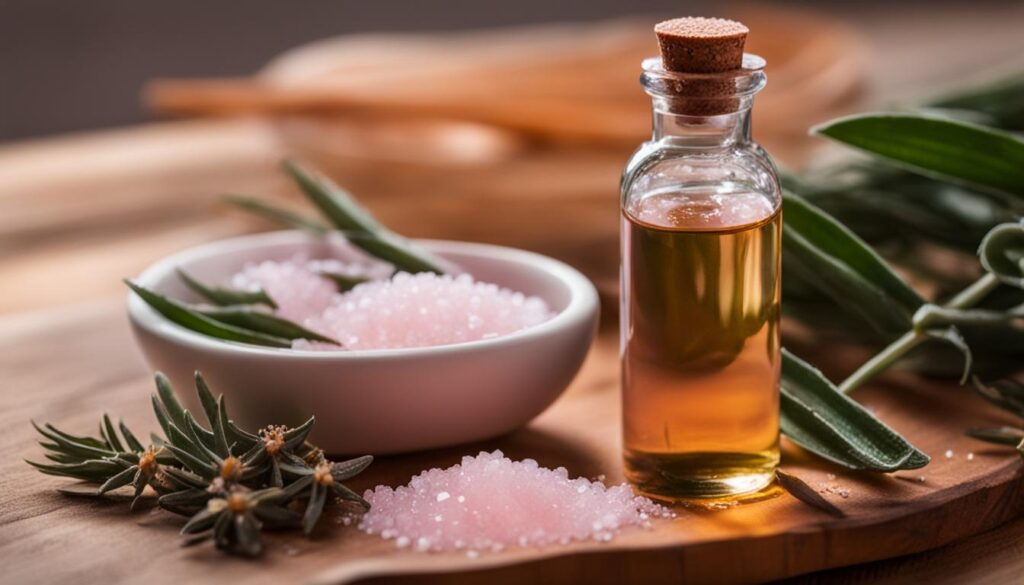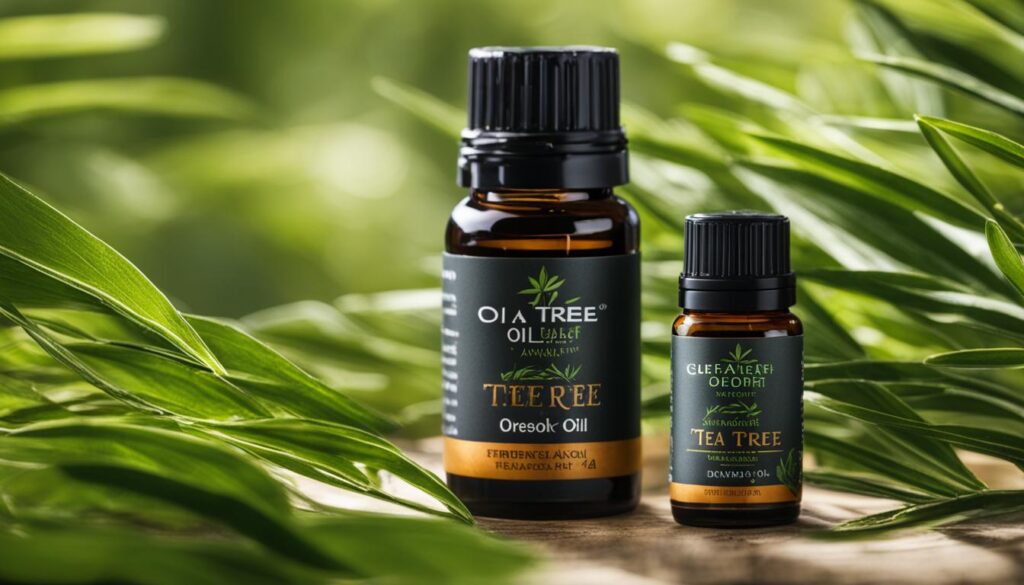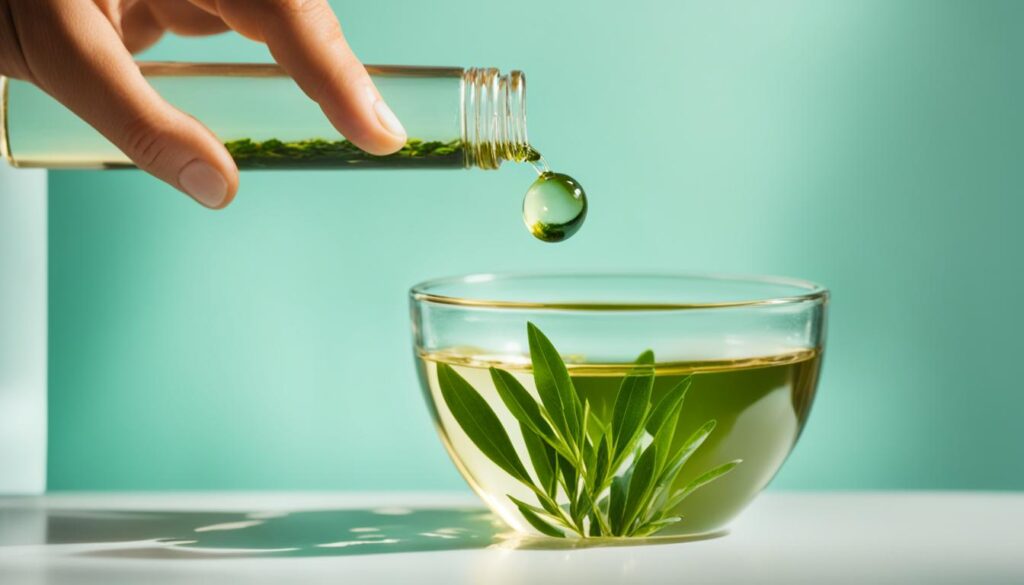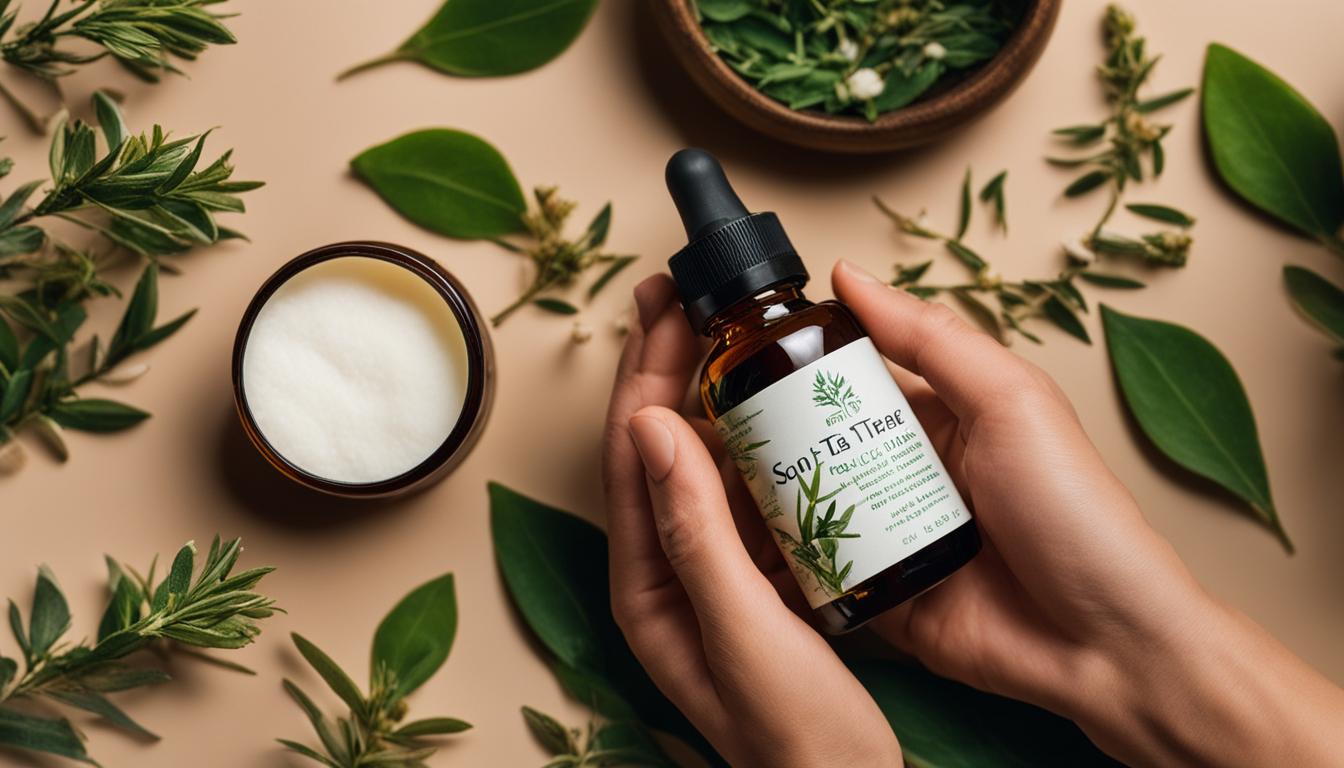Are you dealing with stubborn acne and looking for natural remedies? Look no further than tea tree oil. Derived from the tea tree plant native to Australia, tea tree oil has been used for centuries in folk medicine for its antibacterial and anti-allergic properties. It’s a popular ingredient in many DIY acne treatments, thanks to its ability to fight acne-causing bacteria and reduce inflammation.
In this article, I’ll guide you through various ways to use tea tree oil for acne, including targeted spot treatments and soothing face masks. I’ll also share tips on dilution and where to find the best tea tree oil products. Let’s dive in!
Key Takeaways:
- Tea tree oil is a natural remedy for acne due to its antibacterial and anti-inflammatory properties.
- Dilute tea tree oil before applying it to the skin to avoid irritation.
- Various DIY spot treatments and face masks can be made using tea tree oil.
- Look for high-quality tea tree oil products from reputable brands.
- Take precautions when using tea tree oil, especially if you have sensitive skin or are exposed to sunlight.
How to Use Tea Tree Oil for Acne
Tea tree oil is a versatile and effective remedy for treating acne. There are various ways to incorporate tea tree oil into your acne treatment routine, providing targeted care for blemishes and promoting clearer skin.
Mix with Witch Hazel Toner: One method is to mix a few drops of tea tree oil with witch hazel toner. This combination harnesses the antibacterial properties of tea tree oil and the astringent properties of witch hazel to cleanse the skin and reduce inflammation. Apply the mixture to the affected area using a cotton swab for spot treatment.
Combine with Aloe Vera Gel: Another option is to combine tea tree oil with aloe vera gel. Aloe vera has soothing and healing properties, making it an excellent addition to tea tree oil for acne. Mix a few drops of tea tree oil with a small amount of aloe vera gel and apply it directly to pimples or acne-prone areas for an effective spot treatment.
Add to Face Masks: Tea tree oil can also be added to homemade face masks for acne. Consider mixing it with ingredients like clay or tomato pulp to create a purifying and clarifying mask. This combination helps absorb excess oil, unclog pores, and reduce the appearance of acne scars over time.
Use in Scrubs: For a natural exfoliating scrub, mix tea tree oil with a carrier oil like jojoba oil and add a few drops of lavender oil. Gently massage the scrub onto your skin in circular motions to remove dead skin cells and reveal a brighter complexion. This scrub can help reduce acne and leave your skin glowing.
Remember, it is important to dilute tea tree oil before use, as applying it directly to the skin can cause irritation. Use it in appropriate proportions with carrier oils, toners, gels, or other ingredients to ensure its maximum benefits for treating acne.
In the next section, we will explore the numerous benefits of using tea tree oil for acne, including its antibacterial and anti-inflammatory properties, as well as its ability to balance oil production and reduce the appearance of scars.
Benefits of Using Tea Tree Oil for Acne
Tea tree oil offers several benefits when it comes to treating acne. Its antibacterial properties help fight acne-causing bacteria, while its anti-inflammatory properties reduce redness and swelling associated with acne. Tea tree oil can also help regulate oil production, minimize the appearance of pores, and dry out pimples, whiteheads, and blackheads. In addition, it can aid in healing acne and acne scars by promoting the healing process and supporting healthy skin.
| Benefits of Tea Tree Oil for Acne | How Tea Tree Oil Helps |
|---|---|
| Antibacterial properties | Kills acne-causing bacteria |
| Anti-inflammatory properties | Reduces redness and swelling |
| Regulates oil production | Controls excess sebum production |
| Minimizes the appearance of pores | Shrinks and tightens pores |
| Dries out pimples, whiteheads, and blackheads | Aids in drying out and unclogging pores |
| Promotes healing of acne and acne scars | Supports the skin’s natural healing process |
Tea tree oil is a versatile and effective natural remedy for acne. Its numerous benefits make it a valuable addition to any skincare routine targeting acne. By harnessing the power of tea tree oil’s antibacterial and anti-inflammatory properties, individuals can achieve clearer skin and reduce the appearance of blemishes. Additionally, its oil-regulating properties can help balance oily skin, minimizing breakouts. Overall, tea tree oil is a natural and beneficial solution for those seeking to combat acne and promote healthier skin.
Homemade Tea Tree Oil Acne Spot Treatments
Are you looking for natural spot treatments for acne that can be easily made at home? Look no further! Tea tree oil is a powerful ingredient that can help control blemishes and promote clear skin. Here are some DIY tea tree oil spot treatments that you can try:
Mixture of Tea Tree Oil and Witch Hazel Toner
A simple yet effective spot treatment can be created by combining tea tree oil and witch hazel toner. Witch hazel is known for its astringent properties, making it an ideal partner for tea tree oil in targeting acne. Simply mix a few drops of tea tree oil with witch hazel toner and apply it to the affected areas using a cotton swab. Leave it on overnight and rinse off in the morning for best results.
Tea Tree Oil with Aloe Vera Gel
Another great natural remedy for acne is a mixture of tea tree oil and aloe vera gel. Aloe vera gel has soothing and healing properties that can help calm inflammation and reduce redness caused by acne. Mix a few drops of tea tree oil with a small amount of aloe vera gel and apply it directly to the acne spots. Leave it on for 20 minutes and rinse off with lukewarm water.
Tea Tree Oil Combined with Clay, Jojoba Oil, or Tomato Pulp
You can also experiment with combining tea tree oil with other ingredients to create customized spot treatments. Clay, such as bentonite or kaolin, is excellent for absorbing excess oil and impurities from the skin. Mix a few drops of tea tree oil with clay and water to form a paste, apply it to the acne spots, and let it sit for 15-20 minutes before rinsing off.
Alternatively, you can mix tea tree oil with jojoba oil, a lightweight oil that closely resembles the skin’s natural sebum. This combination can help balance oil production and moisturize the skin while treating acne. Apply a few drops of the mixture to the affected areas and gently massage it in.
An interesting option is to combine tea tree oil with tomato pulp. Tomatoes contain natural acids that help exfoliate the skin and reduce the appearance of acne scars. Blend a ripe tomato and add a few drops of tea tree oil to create a paste. Apply it to the acne spots and leave it on for 15 minutes before rinsing off.
These homemade tea tree oil acne spot treatments are easy to make and can provide effective relief for blemish control and clear skin. Remember to always do a patch test before applying any new ingredient to your face and consult a dermatologist if you have any concerns.

Other Benefits of Tea Tree Oil
Tea tree oil is not just beneficial for acne treatment, it offers a wide range of other benefits for overall skin and hair health.
1. Natural Deodorant
If you’re looking for a natural and effective deodorant, tea tree oil is a great option. Its antibacterial properties help fight odor-causing bacteria, keeping you fresh throughout the day.
2. Antiseptic
Tea tree oil is a powerful antiseptic that can be used to clean and disinfect cuts, wounds, and minor skin irritations. Its natural properties help prevent infection and promote faster healing.
3. Chemical-Free Mouthwash
Using tea tree oil as a mouthwash can help maintain oral hygiene without the use of harsh chemicals. Its antibacterial properties help kill bacteria in the mouth, preventing bad breath and gum infections.
4. Nail Fungus Treatment
Tea tree oil is known for its antifungal properties, making it an effective remedy for nail fungus. Applying tea tree oil to affected nails can help eliminate the fungus and promote healthier nail growth.
5. Relief from Dandruff
Dandruff can be bothersome, but tea tree oil can help alleviate the symptoms. Its antifungal properties target the fungus that causes dandruff, reducing itchiness and flaking.
6. Soothing Psoriasis
Psoriasis is a chronic skin condition characterized by red, itchy, and scaly patches. Tea tree oil’s anti-inflammatory properties can help soothe psoriasis symptoms and reduce inflammation.
With its versatile applications, tea tree oil proves to be a valuable ingredient for various skincare and haircare concerns, extending beyond acne treatment.

How to Dilute Tea Tree Oil for Acne
Tea tree oil is a powerful ingredient for treating acne, but it should always be diluted before use to avoid potential skin irritation. Diluting tea tree oil not only prevents adverse reactions but also ensures the effectiveness of the treatment. There are several options for diluting tea tree oil:
- Water: You can dilute tea tree oil with water at a ratio of 2-3 drops of tea tree oil per tablespoon of water. Mix well before applying it to your skin.
- Aloe Vera Gel: Another option is to dilute tea tree oil with aloe vera gel. Add 2-3 drops of tea tree oil to a tablespoon of aloe vera gel and mix thoroughly. This combination not only dilutes the oil but also provides soothing properties to calm the skin.
- Carrier Oils: Tea tree oil can also be diluted with carrier oils such as coconut oil, almond oil, or olive oil. These oils help to nourish the skin while diluting the tea tree oil. Mix 2-3 drops of tea tree oil with a tablespoon of carrier oil and blend well before applying.
Remember, the key is to find the right balance between the tea tree oil and the diluent. Following the recommended dilution ratios will minimize the risk of adverse reactions while ensuring the potency of the treatment. Take care to test the diluted solution on a small area of skin before applying it to your entire face.
Why Dilution is Important
“Proper dilution of tea tree oil is crucial to prevent skin irritation and maintain the effectiveness of the treatment.”
Diluting tea tree oil is essential because it is a concentrated and potent essential oil. Applying undiluted tea tree oil directly to the skin can lead to redness, itching, and even chemical burns. By diluting it with water, aloe vera gel, or carrier oils, you can enjoy the benefits of tea tree oil without the risk of irritation.
Summary
Dilution is a critical step when using tea tree oil for acne. By diluting tea tree oil, you can protect your skin from potential irritation while harnessing its antibacterial and anti-inflammatory properties. Whether you choose to dilute with water, aloe vera gel, or carrier oils, always follow the recommended dilution ratios. Take care of your skin and enjoy the benefits of tea tree oil for acne treatment.

Where to Find the Best Tea Tree Oil
When it comes to purchasing tea tree oil for acne treatment, it is essential to choose from reputable brands and suppliers that offer high-quality products. Here are some of the best tea tree oil brands available in the market:
- Nykaa Naturals
- Fabindia
- Organic Harvest
- Soulflower
- Aroma Treasures
- St. Botanica
- Aroma Magic
- The Body Shop
- Kama Ayurveda
- Vedic Line
These brands are known for providing pure and 100% natural tea tree oil that is suitable for acne treatment. Whether you prefer to buy tea tree oil online or at health food stores, you can find these reliable brands to meet your needs.
When purchasing tea tree oil, it is important to prioritize quality and ensure that the product is sourced from reputable suppliers. This ensures that you are getting the best tea tree oil with its beneficial properties intact.
Now that we know where to find the best tea tree oil, let’s explore the precautions for using it on acne in the next section.
Precautions for Using Tea Tree Oil on Acne
When it comes to using tea tree oil or any essential oil on your skin, it’s essential to take certain precautions to ensure safety and avoid any potential issues. Here are some important precautions to keep in mind:
- Avoid Direct Application: Tea tree oil should never be applied directly to the face or any other part of the skin. This is because undiluted tea tree oil can cause skin irritation and sensitization. It is crucial to dilute tea tree oil with a carrier oil, such as coconut oil or almond oil, before use.
- Perform a Patch Test: Before applying tea tree oil to your entire face, it’s recommended to perform a patch test. Apply a small amount of diluted tea tree oil to a small area of your skin (e.g., forearm) and wait for 24 hours to check for any adverse reactions. If you experience redness, itching, or any other signs of skin sensitivity, avoid using tea tree oil on your face.
- Avoid Sun Exposure: Essential oils, including tea tree oil, can make your skin more sensitive to sunlight. It is advisable to use tea tree oil-based products, such as acne treatments or face masks, at night to minimize the risk of sun damage. If you need to use tea tree oil during the day, make sure to apply a broad-spectrum sunscreen with SPF 30 or higher to protect your skin.
- Precautions with Essential Oils: Tea tree oil is just one of the many essential oils available. If you are new to using essential oils, it’s important to educate yourself about the proper usage and precautions associated with each oil. Different essential oils have varying levels of potency and potential side effects. Always follow the recommended dilution ratios and guidelines for safe usage.
By following these precautions, you can ensure that you safely incorporate tea tree oil into your acne treatment routine without experiencing any adverse reactions or complications.
Conclusion
In summary, tea tree oil is a powerful and natural remedy for acne. Its antibacterial properties help fight acne-causing bacteria, while its anti-inflammatory properties reduce redness and swelling. Additionally, tea tree oil helps balance oil production, minimize pores, and dry out blemishes, whiteheads, and blackheads. By incorporating tea tree oil into spot treatments, face masks, and toners, individuals can effectively target blemishes and achieve clearer skin.
Dilution is key when using tea tree oil to ensure safe and effective application. Properly diluting tea tree oil with a carrier oil or other diluent helps prevent skin irritation. In addition, it is important to avoid direct application of tea tree oil to the face and perform a patch test before full application, especially for those with sensitive skin.
With the availability of reputable brands and suppliers, obtaining high-quality tea tree oil is easy. Brands such as Nykaa Naturals, Fabindia, and The Body Shop offer pure and natural tea tree oil suitable for acne treatment. By incorporating tea tree oil into their skincare routine, individuals can experience the numerous benefits this natural remedy provides and achieve healthier, clearer skin.
FAQ
Are homemade tea tree oil acne spot treatments effective?
Yes, homemade tea tree oil acne spot treatments can be effective in reducing blemishes and promoting clear skin. Tea tree oil has antibacterial and anti-inflammatory properties that help fight acne-causing bacteria and reduce redness and swelling associated with acne.
How can I use tea tree oil for acne?
Tea tree oil can be used in various ways for acne treatment. Some methods include mixing a few drops of tea tree oil with witch hazel toner or aloe vera gel and applying it to the affected area. Tea tree oil can also be added to face masks made with clay or tomato pulp or used in a scrub with lavender oil for glowing skin.
What are the benefits of using tea tree oil for acne?
Tea tree oil offers several benefits for acne treatment. Its antibacterial properties help fight acne-causing bacteria, while its anti-inflammatory properties reduce redness and swelling. Tea tree oil can also regulate oil production, minimize the appearance of pores, and dry out pimples, whiteheads, and blackheads.
Are there other uses for tea tree oil besides acne treatment?
Yes, tea tree oil has various other uses. It can be used as a natural deodorant, an antiseptic for cleaning cuts, and a mouthwash for oral care. Tea tree oil is also effective in treating nail fungus, dandruff, and soothing psoriasis.
How should I dilute tea tree oil for acne?
Tea tree oil should always be diluted before use to avoid skin irritation. It can be diluted with water, aloe vera gel, or carrier oils such as coconut oil, almond oil, or olive oil. The proper dilution ratio is typically 2-3 drops of tea tree oil per 1 tablespoon of carrier oil or other diluent.
Where can I find high-quality tea tree oil?
There are several reputable brands and suppliers that offer high-quality tea tree oil. Some popular options include Nykaa Naturals, Fabindia, Organic Harvest, Soulflower, Aroma Treasures, St. Botanica, Aroma Magic, The Body Shop, Kama Ayurveda, and Vedic Line. Tea tree oil can be purchased online or at health food stores.
What precautions should I take when using tea tree oil on acne?
Tea tree oil should never be applied directly to the face, as it may cause skin irritation. It should always be properly diluted with a carrier oil before use. It is also recommended to use essential oils, including tea tree oil, at night as they can make the skin photosensitive and increase the risk of sun damage. Individuals with sensitive skin should perform a patch test before applying tea tree oil to the entire face.

